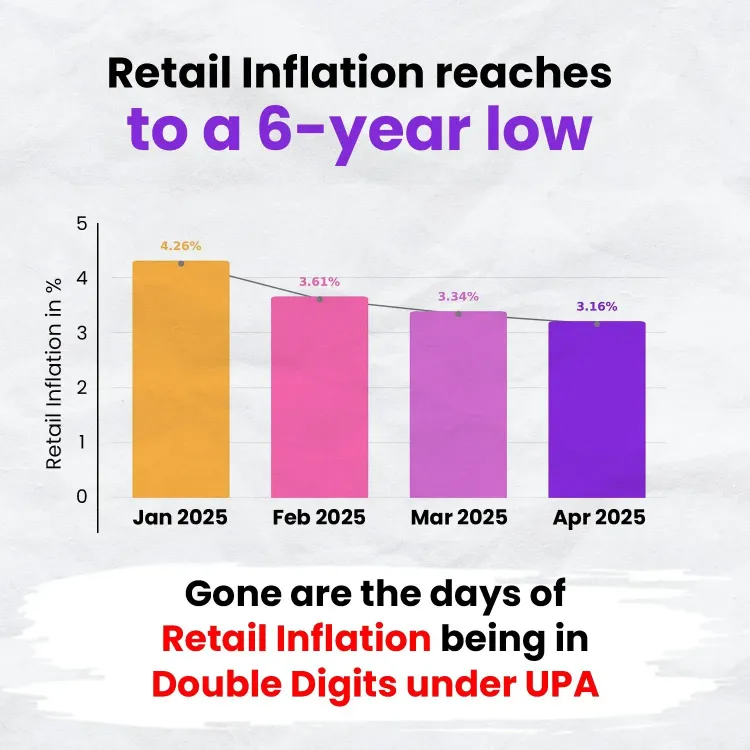How has the PM Modi-led NDA government curbed retail inflation compared to the UPA regime?

Synopsis
Discover how the NDA government under Prime Minister Modi has successfully managed retail inflation, especially in food and fuel, outperforming the previous UPA regime. This analysis sheds light on the strategies implemented and their impacts, making it a crucial read for those keen on economic trends.
Key Takeaways
- NDA government has effectively controlled inflation since 2014, maintaining rates below 8 percent.
- April 2025 retail inflation recorded at 3.16 percent, the lowest in six years.
- Strategic initiatives like the PM Garib Kalyan Anna Yojana have provided free rations to millions.
- The introduction of 'Bharat' brands has made essential goods more affordable.
- Fuel prices have been reduced to benefit consumers, especially through LPG subsidies.
New Delhi, May 14 (NationPress) Recent official statistics reveal that the NDA government, led by Prime Minister Narendra Modi, has significantly outperformed the UPA regime in managing retail inflation, particularly concerning food and fuel.
BJP leader Amit Malviya highlighted on the X social media platform that the double-digit inflation rates (exceeding 10 percent) prevalent during the UPA era are now a thing of the past, showcasing effective governance and price regulation over the last decade.
Since 2014, retail inflation has remained below 8 percent, contrasting sharply with the UPA's average of 8.1 percent from 2004 to 2014, which included a high of 10.4 percent between 2009 and 2014.
In stark contrast, from January 2012 to April 2014, inflation exceeded 9 percent for 22 out of 28 months under the UPA, with nine instances of it hitting double digits.
Malviya, who serves as the chief of the BJP Information Technology cell, noted that retail inflation dipped to 3.16 percent in April 2025, marking the lowest point in nearly six years and continuing a positive trend.
For FY 2024-25, the retail inflation rate stood at 4.6 percent, the lowest since 2018-19, indicating a consistent decline over three years.
The data strongly suggests enhanced inflation control, particularly in food and fuel, under the NDA as compared to the UPA.
The NDA government has effectively managed inflation through strategic initiatives such as the PM Garib Kalyan Anna Yojana, which offers free rations to over 80 crore citizens (extended until 2029), and the introduction of 'Bharat' brands for affordable retail sales of cereals and pulses via NAFED, NCCF, and Kendriya Bhandar.
Additionally, a dynamic buffer stock of pulses is maintained under the Price Stabilisation Fund, with calibrated stock releases ensuring availability and affordability for consumers.
The government is actively offloading wheat and rice from the central pool through the Open Market Sale Scheme to enhance market availability and stabilize retail prices.
Regarding fuel, the LPG subsidy has been reduced, benefiting both PM Ujjwala users and regular consumers, with a Rs 100 price cut on non-subsidised LPG cylinders effective March 9, 2024.
sps/na





